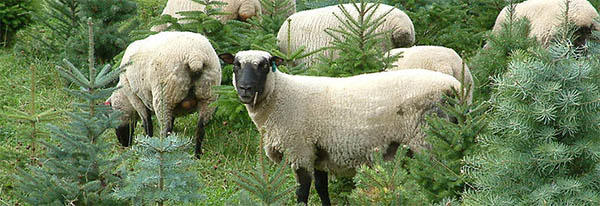
Woodworkers’ interaction with wood often starts with a piece that has already been harvested and is just waiting to be purchased at the lumberyard. Steve Gabriel’s relationship with wood is a little different: as a specialist in topics like agroforestry and silvopasture, Steve’s encounters with wood are when it’s “on the hoof,” so to speak.
That’s not an accidental turn of phrase: as an agroforestry extension specialist for the Cornell Small Farm Program at Cornell University in New York, Steve primarily interacts with existing or would-be farmers. Some of them own existing woodlots. Some are interested in planting trees in conjunction with raising animals or crops. Almost all of them are interested in finding ways to increase their income – and that just might be where the relevance to woodworkers comes in.
For example, Steve noted that, although maple syrup producers obviously have a vested interest in keeping their trees alive to continue producing the maple sap, eventually all trees’ lives come to an end. In this case, portions of that wood could be what’s known as taphole maple: a spalted design created when the tree receives the puncture wound from the tapping, as well as remnant holes in the wood from the taps themselves. Many farmers, however, don’t realize there’s a value in that wood, Steve said. “The perception is, ‘The only value is wood that’s clear, clean, veneer quality.’”
There’s potential, Steve noted, “for farmers to expand more of what they cultivate for the wood products world.”
So, what is agroforestry? And silvopasture (other than the title of Steve’s new book, Silvopasture, ISBN 1603587314, published by Chelsea Green)?
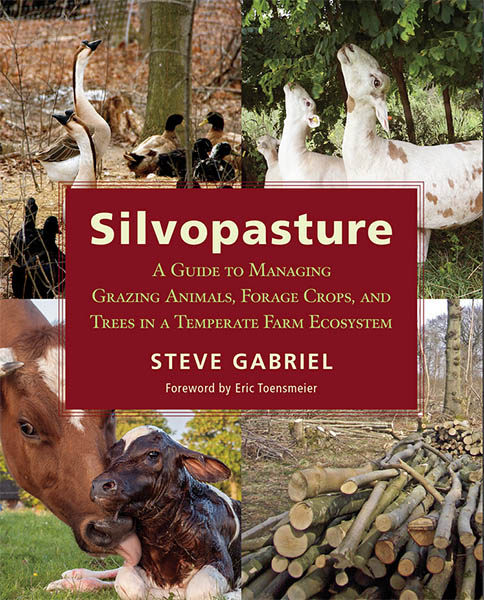
Agroforestry, Steve said, is the name for the practice “that has been really how humans have existed on most of the earth for the longest time, where the production of food or medicine or other products that we associate with farming is mixed with forestry.” Those farming products might be tree saps or syrups; fruits and nuts; mushrooms; or medicinals. Ginseng, for example, would be an agroforestry crop grown in a certain type of forest.
The type of agroforestry in which crops are grown under the canopy of an existing forest is called “forest farming” (the subject of Steve’s previous book, Farming the Woods, ISBN 1603585079 coauthored with Ken Mudge and also published by Chelsea Green). Agroforestry can also include practices like alley cropping, in which trees are planted in rows – straight or contoured – with farmed crops planted between the rows, which can then act as windbreaks.
For example, the University of Missouri’s agroforestry efforts include encouraging the planting of black walnut trees, mingled with corn crops. Farmers maintain their corn yield for a time, with windbreak protection from the trees. Eventually, more mature trees will shade out the corn – at which time the black walnuts will be producing nuts which can also serve as a cash crop.

Silvopasture, in turn, refers to the practice of integrating forestry management with grazing animals.
“I think the oldest silvopasture system that we have documentation of is the dehesa [Spanish] or montado [Portugese],” some of which have been around for 400 or 500 years, Steve said. In these savannah-like systems, the Portugese tend to harvest cork from cork oak, while in Spain, Steve said, the trees are most often cultivated for their acorns, which are then fed to pigs to produce a high-value pork product.
In his own work in the U.S., Steve works both with farmers who own an existing woodlot and want to get into silvopasture, and with farmers who are planting trees in the pasture and can therefore select what species they favor. “When we do good managed grazing mixed with tree planting, that actually puts the most carbon in the soil,” Steve said. “It is really ranked among the best farming practices in terms of its impact on the climate.” Plus, he noted, as farmers choose their tree species, “That has the potential to provide good woodworking material.”
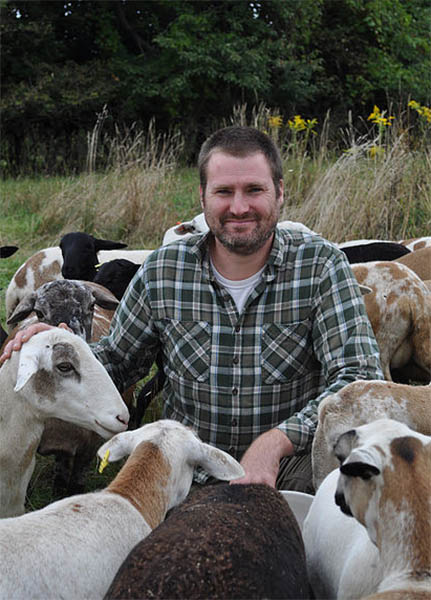
Right now, there is probably some good wood sitting on the ground from farmers who entered silvopasture with an existing timber stand on their property. “In most cases, you really have to thin the woodlot pretty heavily, like to 50 percent canopy cover, because you need to get enough light in there to establish some forage for the grazing animals,” Steve explained. “What that results in is a lot of thinning of lower canopy species, because we’re most just focused on trying to open up the understory.”
The wood that comes out of such projects is often not large enough to go to a mill to be converted into standardized lumber. Sometimes it gets taken to a nearby biomass plant to be used for fuel; sometimes someone buys some for firewood. “Maybe the farmer grabs a little bit of firewood for themselves, but there’s a lot of wood that just ends up being dragged off into the corner and kind of piled up because it doesn’t have an economic return and the so the farmer or the logger, whoever’s doing the work, doesn’t think it’s worth dragging out of the woods,” Steve said.
Connecting with woodworkers, he noted, “would be a huge benefit to being able to actually help us create silvopasture, because the trick is, how do we get all that thinning done in a way that it also pays for the labor or the machinery to do the work?”
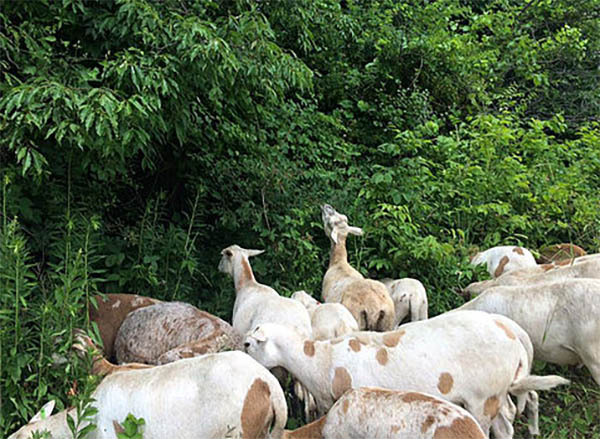
When creating silvopasture through tree plantings, Steve said, “Almost any species can be used. It kind of depends on what the goals of the farm area. We’re really interested in planting a lot of trees mostly to shade the animals and also as a food source for them.”
Generally, this does mean farmers pursuing silvopasture are interested in faster-growing tree species as fodder for their cows, sheep and, sometimes, goats. Goats are more likely to eat woody vegetation, stripping bark, while sheep and cows “tend to be more into the leaves,” Steve said. Faster-growing trees are also an advantage because “we do have to keep the animals off of them for some given amount of time so that the tree can sort of establish itself and not succumb to, basically, getting beat up,” Steve said – noting that cattle, due to their weight, “just run things over.”
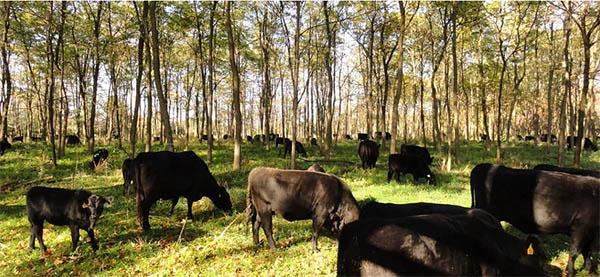
Some of Steve’s favorite tree species for silvopasture include black locust, poplar, mulberry, willow and basswood. “We’ve had locusts on the farm that, after three or four years, you can graze again,” he said – while noting that the timeframe for regrazing with a black walnut silvopasture, for example, might be 15 years.
Black walnut can, however, be used in silvopasture: most pasture grasses are tolerant of the toxins the tree releases, Steve said, and the toxicity doesn’t affect the animals. And black locust, on the other hand, does have a woodworking interest as well: it’s popular in the Northeast, Steve said, as wood for constructing rot-resistant posts.
He also made sure to mention a very old practice of silvopasture that has advantages both to the farmer and, potentially, to the woodworker. The practice of pollarding, he said, “is where you cut the tree at browse height, so like five or six feet off the ground, and allow the tree to resprout and regrow multiple shoots, and then you can actually harvest those shoots for the animals. You can actually store them just like hay.
“But what’s really cool about that is, to develop a really good pollard system, what you do is, the farmer manages the tree to create a burl on top of it. This is something that works for the farm, but eventually that burl could actually be harvested, which I know is another kind of woodworking interest for folks. That is a way to actually produce that kind of material and mix it in with a grazing system.”
Interested in learning more about agroforestry and/or silvopasture? It’s a relatively young effort in the U.S., Steve said, so while most states’ university extension offices might have some familiarity with the topic, they might not have a lot of resources. “There’s a lot more to learn and think about as we kind of adapt it to different regions,” he said. Some resources are available through Cornell’s Small Farm Program.
“The potential is there; there’s lots of opportunities,” Steve said. “Woodworkers should be encouraged to connect with farmers and folks practicing agroforestry because the demand that they create for the products they’re interested in could really help economically allow us to do more of this, and I think that that benefits everybody in the long term.”





